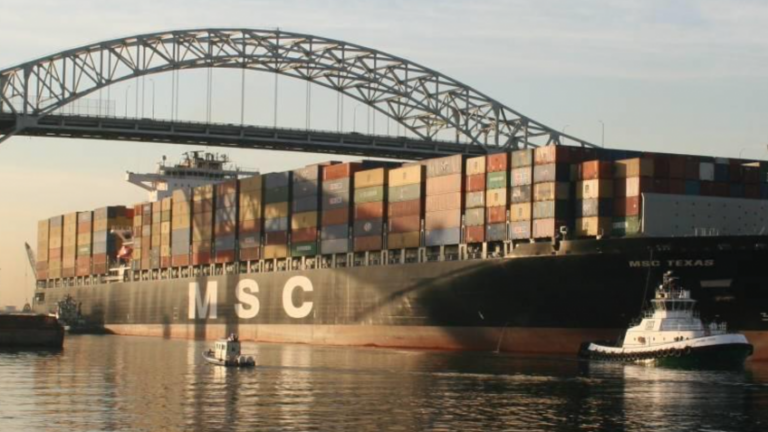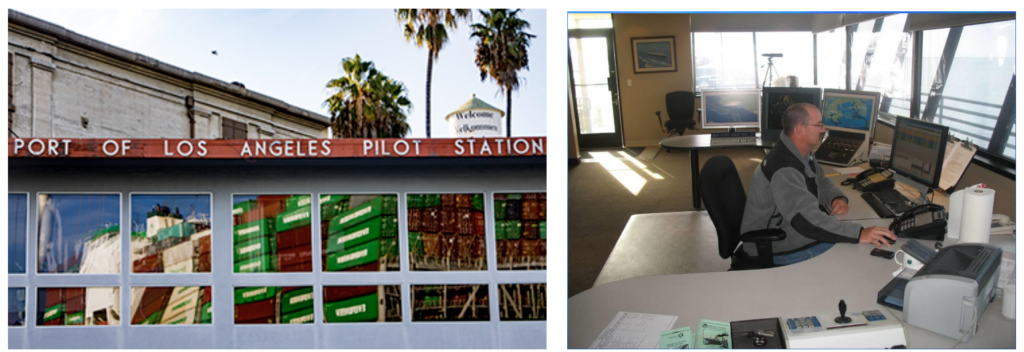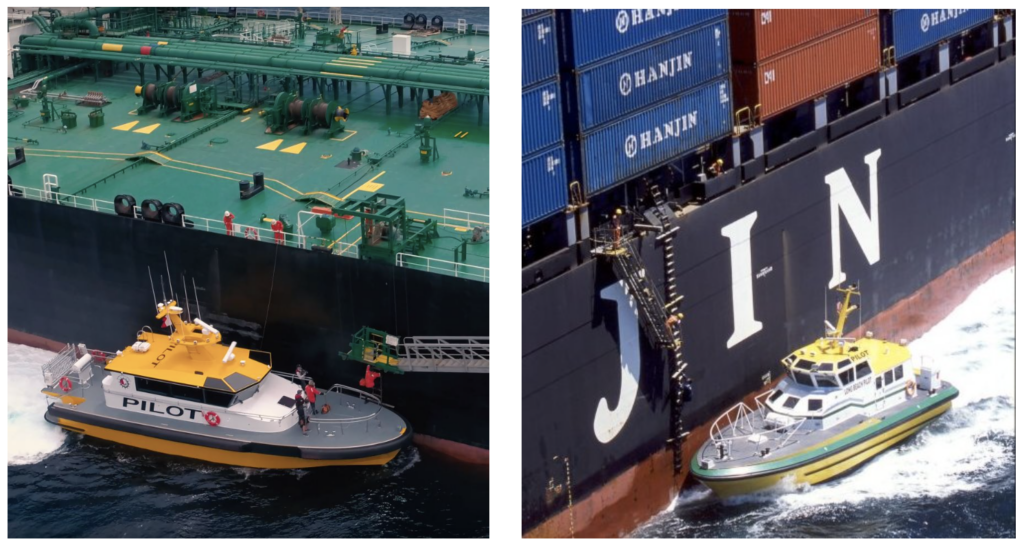
Tug and pilot service at the Port of Long Beach is provided by Jacobsen Pilot Service. Source: Jacobsen Pilot Services, Inc.
15. Vessel Pilots: Ensuring Safe Port Calls
Author: Dr. James A. Fawcett, USC Sea Grant Maritime Policy Specialist/Extension Director (retired)
Media Contact: Leah Shore / lshore@usc.edu / (213)-740-1960
Throughout the world, mariners rely upon nautical charts to guide their voyages, to assist them in avoiding obstructions, and to note any special ocean conditions when sailing. However, each seaport or harbor has unique local conditions that can change due to construction, storm events, or other circumstances that are not noted on nautical charts. These unique conditions, therefore, require mariners to seek advice from a local expert, known as a vessel pilot, upon entering any seaport in the world.
Port Pilots
By virtue of narrow channel widths, sandbars, and underwater obstructions, vessels need a navigation pilot who has particular local expertise in these types of waters. Moreover, marine insurance carriers demand that ship captains call for assistance upon entering restricted waterways such as seaports. While found in commercial harbors around the world, they also serve in freshwater as both river pilots and on the approach to and passage through locks and canals. Similarly, the professional responsibility of navigation pilots is to assist the vessel captain to safely navigate through the waterway using the pilot’s detailed and updated knowledge. Often unseen by the public, pilots are required to be licensed generally as unlimited vessel masters or limited vessel masters,[1] often with many years of experience at sea or many years of local assistance as tug masters.
Pilots may be employees of the port, employees of the jurisdiction (such as canal pilots), or privately hired; regardless, all are required to have a high level of expertise that would equip them to safely guide ships of all sizes and configurations. The Ports of Los Angeles (POLA) and Long Beach (POLB) provide pilotage of both types. The pilot service of POLA has been in operation since 1907, and its pilots are employees of the City of Los Angeles. In POLB, piloting is provided by a private company, Jacobsen Pilot Service, a firm that has provided pilotage in that port since 1924. Each has a staff of experienced port pilots available 24 hours a day to guide ships displacing hundreds of thousands of tons (and drafts of up to 69 feet) to a safe docking.

The Pilotage Process
Usually days in advance of arrival, the ship’s (or shipping company’s) agent will arrange for line handlers, tugs, and a pilot for incoming vessels. As I have noted earlier, most container ships are in liner service, so their arrival is often set weeks in advance and the pilot service is generally aware of the schedule. Nevertheless, the ship’s agent will finalize their arrival order anywhere from several hours to days in advance. Recently, especially due to the delay in shipping traffic because of COVID-19, container ships have needed to wait outside of the port at anchorages until berth space becomes available. In those cases, the use of pilots is not required as the ships’ officers are well qualified to anchor the vessel at anchorages designated by the vessel traffic service (VTS) or the local pilotage organization.
Upon arrival at the designated pilot boarding area outside the harbor, the vessel will have notified the pilot station several hours in advance that it is ready to embark on a pilot. The pilot will arrive at the ship on a specially designated pilot boat that is flying the international “H” (or “hotel”) flag indicating its identity. The pilot will board the vessel, most often via a pilot ladder (often referred to as a Jacob’s ladder), a rope ladder with wooden treads and “spreaders” or extra-long treads extending horizontally to prevent the ladder from twisting in the wind. The ladder is secured on deck but hangs over the side of the ship and the pilot uses it to climb up to the main deck, often a distance of fewer than nine meters. [2]
On some vessels, a pilot boarding hatch is opened on the side of the ship to accommodate the pilot via a short pilot ladder. Equipped with a radio and often a “portable pilot unit” (PPU)[3], the pilot boards the vessel, heads to the bridge, exchanges introductions with the captain and officers, and after the usual master/pilot exchange of information, assumes the conn for entering the harbor. Meanwhile, the pilot boat returns to its home dock. Despite local expertise and his advice for maneuvering the vessel into port, the captain remains responsible for the vessel and yet would be unwise to ignore the navigation recommendations of the port/bar/river pilot.

Next, tugs are often assigned to assist the pilot in maneuvering the vessel to its assigned berth in the port. This is because the process requires a very low speed that can cause the ship to lose steerageway (the ability to steer itself) due to the ship’s rudder being only effective when water is flowing past it, and at low speeds (typically 5 knots or less) that force can at times be insufficient. Correspondingly, tugs make up lines to push or pull the ship according to instructions from the pilot, and the number of tugs is determined by both the size of the ship and the wind present at the time. With their help, the pilot brings the vessel to its berth, the line handlers on the dock secure the ship to its dock, and the pilot’s job is completed.
Consulting Vessels In Many Locations
In certain locations, such as the mouth of the Columbia River as it enters the Pacific Ocean, pilots are necessary to maneuver vessels over the Columbia River “bar” or shifting shoals at the river mouth that result from sediment deposited there. Transit over the bar is also necessary for ships entering the river to call at the Ports of Portland, Oregon, or Vancouver, Washington.
At the Panama or Suez Canals, pilots are required to assist vessels throughout their transit of these very restricted waterways,[4] and in the Panama Canal, the pilot is responsible for the navigation of the vessel rather than the captain.[5] Similarly, river pilots are required at various points on rivers worldwide to address shoals that shift seasonally and various weather conditions. Oftentimes a river pilot will be onboard for the full transit of vessels, for example, transiting from the Gulf of Siam/Gulf of Thailand upriver to the Port of Bangkok. We have seen the importance of pilotage recently in the dilemma of the M/V Ever Given that became grounded in the Suez Canal, even with a pilot onboard. In the Ports of Los Angeles and Long Beach, all vessels over 300 gross tons require pilotage (with exceptions as noted in their tariffs).[6]
In shipyards, a pilot will board a vessel for both entering or departing from a drydock, a careful maneuvering task that is necessary both to prevent damage to the ship and the drydock, and to position the vessel properly and accurately over its keel and bilge blocks, which support the vessel once the dock is pumped dry.
In essence, the pilot is a consultant to the ship’s captain for the duration of docking or undocking the vessel when entering or departing a confined waterway. Its cost is just one of the many expenses of moving goods at sea; it is paid for by the vessel operator in the same manner as dockage fees and other costs of sailing into a seaport or other restricted waterway.

Certification Provides Safe Vessel Operation Worldwide
Sailing on the high seas is a skill gained by years of practice, care, and attention to the moods of the world’s oceans. To ensure that mariners are similarly trained, demonstrate a common set of essential seamanship skills, and maintain effective watchkeeping while at sea, the International Maritime Organization (IMO), a UN body regulating international sea transportation, called the seagoing nations of the world to Manila, Philippines in 1978 to ratify a set of consistent standards for mariners. The International Convention on Standards, Training, Certification, and Watchkeeping,[7] mandates that Captains and officers of merchant, naval, and other large vessels comply with a set of standards, known to all fellow mariners, to secure safe navigation and operation of vessels at sea. The convention (referred to as STCW) was attended in Manila in 1978 by 85 nations, 21 non-governmental organizations with interests in shipping, and four observer nations. Following this, the STCW entered into force in April 1984.
Maintaining compliance with STCW and the certification requirements of the nation in which their vessel is registered (the “flag state”), mariners sail from port to port with the knowledge and confidence that their vessel will be met and assisted by competent pilots whenever they reach one of these areas of restricted navigation. In the United States, requirements for pilotage are specified by the U.S. Coast Guard[8] for all inland waters (rivers and the Great Lakes), and coastal waters.
Vessel pilots may provide a service not widely known to the public, nevertheless, their skills are vital to the safe operation of every major seaport worldwide. Our major seaports at Los Angeles and Long Beach could simply not operate without their expertise and skill.
Acknowledgments
My sincere thanks to CAPT Tom Jacobsen, President, Jacobsen Pilot Service (pilot service for the Port of Long Beach), CAPT Jay Dwyer, Chief Pilot, Port of Los Angeles and CAPT J. Kipling Louttit, Executive Director of the Marine Exchange of Southern California for their generous assistance and advice.
References
[1] CAPT Tom Jacobsen reports that his firm hires ship or tug boat captains but that they have a three-year training program for pilots. The Port of Los Angeles has a two-year program of the same type.
[2] On ships with freeboard of more than 9 meters (30 feet) the ship is required to provide a “combination arrangement,” a ladder (gangway) with an upper and lower platform that is lowered partway down the side of the ship accessed by a Jacobs ladder from the pilot boat to the lower platform. International Convention for Safety of Life at Sea, (1994) Chapter V, Regulation 23.
[3] A PPU is a Pilot’s tool that assists the local pilot in the safe navigation of the piloted vessel. It does this by incorporating a range of navigation sensors with an electronic chart and display. (See: http://www.adnav.com/articles/what-is-a-ppu-portable-pilot-unit/ for additional details).
[4] Rules of the International Maritime Association and the International Maritime Pilots Association specify that maritime states define the rules for pilotage within their jurisdiction, especially with respect to compulsory pilotage.
[5] Pilot is compulsory in Canal waters based on the Regulation on Navigation in Panama Canal Waters, Article 90, Section One, Chapter V, Pilotage. Additionally, Article 92 states that the pilot assigned to a vessel shall have control of the navigation and movement of such a vessel. Masters should be aware that Panama Canal pilots on board vessels are in control of the navigation and are not in advisory capacity.
[6] Port of Los Angeles. (1989 as revised). Tariff No. 4…, Item 310 (a), P. 48. Also, Port of Long Beach. (1995 as revised). Tariff No. 4…, Item 210 (a-f), P. 2,000,053-054. https://kentico.portoflosangeles.org/getmedia/4509401d-b5ae-42e5-ab0d-a5dae71c44d1/tariff-no-4-update and file:///Users/jamesfawcett/Downloads/Port-Tariff-No.-4-7-1-2021-1.pdf.
[7] IMO. (1978). CONFERENCE OF PARTIES TO THE INTERNATIONAL CONVENTION ON STANDARDS OF TRAINING, CERTIFICATION AND WATCHKEEPING FOR SEAFARERS, 1978: Final Act of the Conference of Parties to the International Convention on Standards of Training, Certification and Watchkeeping for Seafarers (STCW), 1978. Retrieved from https://wwwcdn.imo.org/localresources/en/OurWork/HumanElement/Documents/32.pdf.
[8] 46 CFR § 15.812 Pilots.